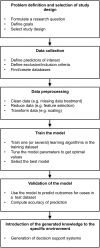Machine learning, statistical learning and the future of biological research in psychiatry
- PMID: 27406289
- PMCID: PMC4988262
- DOI: 10.1017/S0033291716001367
Machine learning, statistical learning and the future of biological research in psychiatry
Abstract
Psychiatric research has entered the age of 'Big Data'. Datasets now routinely involve thousands of heterogeneous variables, including clinical, neuroimaging, genomic, proteomic, transcriptomic and other 'omic' measures. The analysis of these datasets is challenging, especially when the number of measurements exceeds the number of individuals, and may be further complicated by missing data for some subjects and variables that are highly correlated. Statistical learning-based models are a natural extension of classical statistical approaches but provide more effective methods to analyse very large datasets. In addition, the predictive capability of such models promises to be useful in developing decision support systems. That is, methods that can be introduced to clinical settings and guide, for example, diagnosis classification or personalized treatment. In this review, we aim to outline the potential benefits of statistical learning methods in clinical research. We first introduce the concept of Big Data in different environments. We then describe how modern statistical learning models can be used in practice on Big Datasets to extract relevant information. Finally, we discuss the strengths of using statistical learning in psychiatric studies, from both research and practical clinical points of view.
Keywords: Machine learning; outcome prediction; personalized medicine; predictive modelling; statistical learning.
Figures



References
-
- Ashley EA, Butte AJ, Wheeler MT, Chen R, Klein TE, Dewey FE, Dudley JT, Ormond KE, Pavlovic A, Morgan AA, Pushkarev D, Neff NF, Hudgins L, Gong L, Hodges LM, Berlin DS, Thorn CF, Sangkuhl K, Hebert JM, Woon M, Sagreiya H, Whaley R, Knowles JW, Chou MF, Thakuria JV, Rosenbaum AM, Zaranek AW, Church GM, Greely HT, Quake SR, Altman RB (2010). Clinical assessment incorporating a personal genome. Lancet 375, 1525–1560. - PMC - PubMed
-
- Ashworth A, Lord CJ, Reis-Filho JS (2011). Genetic interactions in cancer progression and treatment. Cell 145, 30–38. - PubMed
-
- Barr A, Feigenbaum EA, Cohen PR (1981). The Handbook of Artificial Intelligence. William Kaufmann: Stanford.
-
- Batista G, Monard MC (2002). A study of K-nearest neighbour as an imputation method. Hybrid Intelligent Systems 87, 251–260.
-
- Bishop CM (2006). Pattern Recognition and Machine Learning. Springer: New York.
Publication types
MeSH terms
LinkOut - more resources
Full Text Sources
Other Literature Sources

